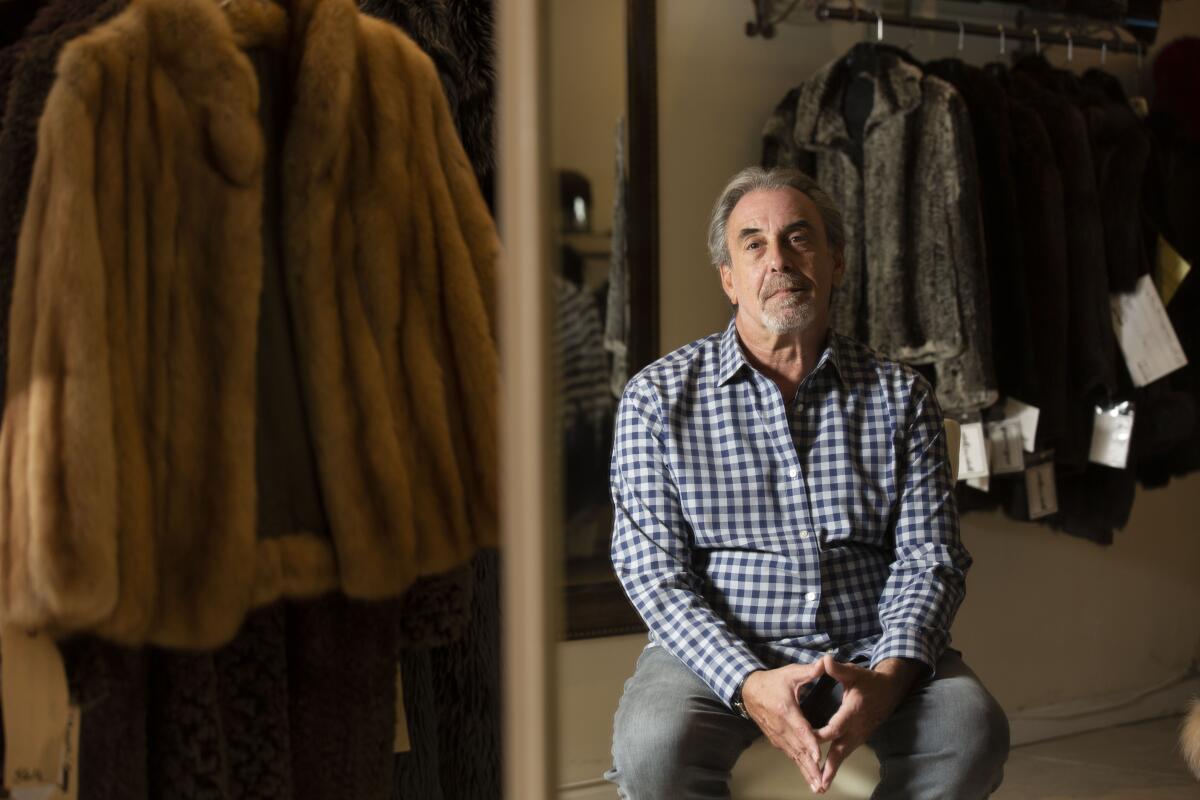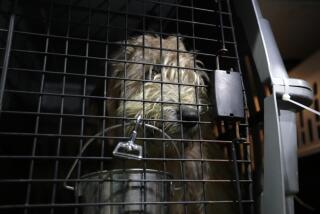As California considers a fur ban, many in L.A. cling to their minks

Decades before gold was discovered at Sutter‚Äôs Mill, fortune-seekers flocked to California for its furs. Now the state is poised to become the first in the country to ban them ‚ÄĒ a legislative drama in which sunny Los Angeles, land of beach curls and flip-flops, is the unlikely star.
The assemblywoman who wrote the fur products prohibition and the state senator who could kill the measure represent overlapping districts in Glendale and Burbank. The animal rights organization that helped craft the ban is headquartered in Sherman Oaks, the fur industry’s national lobby across the San Fernando Valley in Porter Ranch. Los Angeles recently became the largest American city to outlaw the sale, manufacture or trade of most fur products, but that hasn’t stopped Angelenos from flocking to buy them.
‚ÄúI just stocked up for Burning Man,‚ÄĚ said Sean Hammond, a vendor at the hip Melrose Trading Post, who was selling racks of vintage furs on Sunday despite the 85-degree August heat. ‚ÄúDuring the winter they really sell, too.‚ÄĚ

From rabbit-trimmed festival wear to fox slides and mink eyelash extensions, fur remains stubbornly popular in a place where it has never been practical ‚ÄĒ defying oft-repeated tropes of Los Angeles as an animal-rights paradise flowing with vegan doughnuts and cruelty-free mascara.
‚ÄúThere‚Äôs going to be a black market, that I can tell you,‚ÄĚ said Beverly Hills furrier David Appel, who has watched Assembly Bill 44 move through the Legislature with growing apprehension since it was introduced in December. ‚ÄúPeople that want fur get fur, just like people who want marijuana get marijuana.‚ÄĚ
Under AB 44, vintage pelts of the type Hammond sells would remain legal, as would hides from cows, goats, sheep and lambs. But new items made from the fur of undomesticated animals ‚ÄĒ among them coyote, mink and rabbit ‚ÄĒ would be outlawed.
‚ÄúIf you really want to get [new] fur that bad, go to Vegas,‚ÄĚ said Marc Ching, founder and president of Animal Hope in Legislation, the animal rights group behind AB 44 and the Los Angeles ban. ‚ÄúWe‚Äôre residents and we know a lot of people here who are against fur.‚ÄĚ
The state bill passed the Assembly on a bipartisan vote and is currently being weighed by the Senate appropriations committee, where it will remain until Thursday. State Sen. Anthony Portantino (D-La Ca√Īada Flintridge), who chairs the committee and will determine whether AB 44 can move forward, declined through a spokesman to comment on the bill.
But while legislators in Sacramento have largely united around the ban, it has exposed deep rifts in L.A. Though many here see fur as an avatar of cruelty, to others it remains a powerful totem of cultural heritage, historical continuity and Hollywood glamour ‚ÄĒ one many are reluctant to let go.
‚ÄúMy parents being from Iran, there is this infatuation with royalty and gold and fur and jewels that still continues to this day in the diaspora,‚ÄĚ said Donna Ahdoot, who was looking for a ‚Äútouch of glam‚ÄĚ when she left her toddlers for a night out with friends at the buzzy new restaurant Birdie G in Santa Monica last week.
Another night, she might have picked a pair of statement earrings or a bright shade of lipstick ‚ÄĒ but when temperatures dipped into the 60s, she grabbed her mink vest instead. ‚ÄúI enjoy dressing up and feeling regal. I love that part of my heritage,‚ÄĚ Ahdoot said.
Critics of the law say it singles out some ethnic and religious groups while shielding others. Religious articles worn by Native Americans and Ashkenazi Jews are exempted, they point out, while fox stoles popular at black churches and Persian synagogues are not.
‚ÄúWhat makes their religion more important?‚ÄĚ said Irene Gandy, a Broadway press agent who heads the Coalition for Blacks for Furs in New York, where proposed fur bans have drawn widespread ire. ‚ÄúWe go to church, we‚Äôre still praying. We have as much right to wear our furs for our faith.‚ÄĚ
Gandy recalled how her great-grandmother used an employer’s castoff fur coat as collateral to pay for her great-grandfather’s burial. Tanisha Ford, an associate professor of Africana studies and history at the University of Delaware and a leading scholar of black fashion, said such experiences are common, and that they lend cultural weight to a product widely seen as extravagant.
‚ÄúIt‚Äôs not just about style ‚ÄĒ the style piece is an investment,‚ÄĚ she said. ‚ÄúThis dates back to a history of segregation in this country that denied us access to goods and services and property,‚ÄĚ where a fur often served as a form of wealth. ‚ÄúSome members of the African American community feel there is a racial component to this ban that [legislators] need to be aware of.‚ÄĚ
But Assemblyman Chris Holden (D-Pasadena), a member of the California Legislative Black Caucus, slammed the idea that culture excused animal cruelty at a hearing on AB 44 earlier this year.
‚ÄúTo suggest that there‚Äôs a cultural connection to this issue trivializes the point,‚ÄĚ Holden said. ‚ÄúIt focuses on a divisive issue.‚ÄĚ
Most fur-bearing animals have never been domesticated, which makes raising a fox for the trim of a parka inherently crueler than aborting a karakul lamb for a wool cap, animal rights activists say. Though abuses in the meat industry are well documented, the state has strict regulatory frameworks meant to curb them, while fur worn in the U.S. largely comes from abroad, where conditions are difficult to monitor.
‚ÄúFur animals are not subject to humane slaughter laws,‚ÄĚ said Veronica Rafkind, co-founder of Animal Hope in Legislation. ‚Äú[Californians] are supposed to lead when it comes to the inhumane treatment of animals or people or anything. It affects our own humanity, our own ability to empathize with others.‚ÄĚ
Last fall, California voters passed Proposition 12, which bans the sale of meat and eggs from animals that were tightly confined ‚ÄĒ proof of a growing appetite for animal welfare legislation in the state, supporters of the new bill said.
‚ÄúPeople in California want to know that if they buy an animal product in California that it was humanely raised and sourced,‚ÄĚ said Assemblywoman Laura Friedman, the bill‚Äôs author. ‚ÄúI don‚Äôt claim to speak for all cultures, but I would hope that people would care for the welfare of wild animals being raised in small, cramped cages, chewing on their legs because they‚Äôre so stressed and being anally electrocuted for their fur.‚ÄĚ
State legislators in New York and Hawaii have already introduced similar bans, with more states expected to follow, said P.J. Smith, fashion policy director at the Humane Society of the United States.
‚ÄúCalifornia has a good chance to be a leader on this issue and pave the way for other states,‚ÄĚ he said.
But California’s most popular fur product will remain legal even if Portantino allows AB 44 through the appropriations committee and onto the floor of the Senate, where it’s widely expected to pass.
Mink eyelash extensions, which are harvested by ‚Äúgently brushing‚ÄĚ mink in captivity, are coveted by young Angelenos who would never wear the coat that same creature will later become.
‚ÄúMink hair is the closest to our eyelashes,‚ÄĚ explained Gloria Ting of Beverly Hills Lashes, where a set of Siberian mink eyelash extensions run upward of $300, significantly more than the same service with synthetics. ‚ÄúWhen I first started, 75% of clients would be doing Siberian mink, even just regular folks. Now it‚Äôs the higher-end clientele.‚ÄĚ
Though their popularity has dipped as cheaper synthetic options have improved, mink are still prized by many for their natural appearance.
‚ÄúIt‚Äôs a secret that they don‚Äôt talk about,‚ÄĚ Ting said of her mink-wearing clients. ‚ÄúI do have a lot of celebrity clients that tell us not to tell anyone that they‚Äôre our clients and that they wear extensions ‚ÄĒ and definitely not that they‚Äôre mink.‚ÄĚ
Critics of AB 44 say it legislates the early death of an industry that’s already on the way out.
Appel said his younger clients mostly wear vintage fur. Larry Becker of Dicker & Dicker of Beverly Hills specializes in candy-colored coats and knit fur statement pieces ‚ÄĒ but he‚Äôs also found a niche ‚Äúremodeling‚ÄĚ old furs into blankets, teddy bears and coats for small dogs.
For the women who buy these items, the #iwokeuplikethis aesthetic of mink lashes has long since eclipsed the silver screen glamour of mink stoles, even in communities where the latter remain popular.
‚ÄúIf you‚Äôre a young Persian woman and you‚Äôre wearing a lot of bling on your fingers, you can say my husband bought that for me or it was a ‚Äėpush present‚Äô after I had the triplets. But to walk into a room draped in fur is too ostentatious even for our community,‚ÄĚ said Tabby Refael, an Iranian refugee and a prominent chronicler of Persian L.A. ‚ÄúThis is Los Angeles ‚ÄĒ who the hell wears fur?‚ÄĚ
More to Read
Sign up for Essential California
The most important California stories and recommendations in your inbox every morning.
You may occasionally receive promotional content from the Los Angeles Times.











